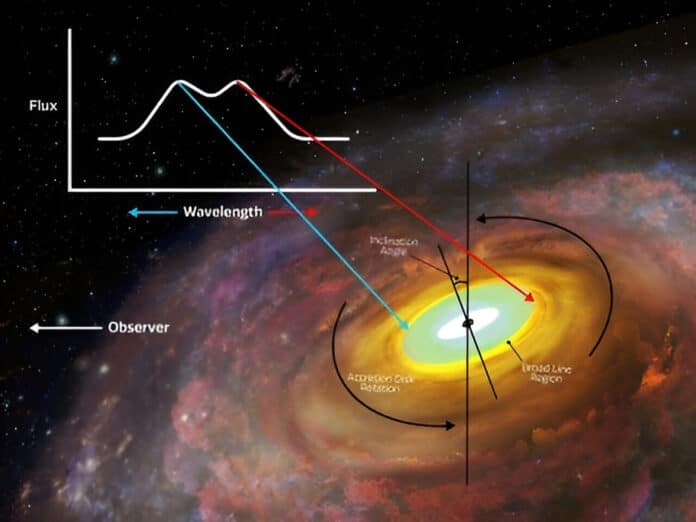Astronomers have discovered evidence of an accretion disk within the active galactic nucleus of galaxy III Zw 002 for the first time using the Gemini North telescope, one-half of the International Gemini Observatory, operated by NSF’s NOIRLab. These discoveries put precise constraints on the size of the galaxy’s accretion disk and shed new light on its structure and behavior using two rare and peculiar near-infrared emission lines.
Many galaxies include a supermassive black hole actively feeding in a tumultuous environment at their center. These inconceivably dense objects are orbited by spinning accretion disks of gas and dust, which feed the black hole and produce abundant amounts of energy across the electromagnetic spectrum, from high-energy gamma and X-rays to visible light, infrared, and radio waves.
Astronomers’ understanding of black holes and the development of their host galaxies can be improved by studying accretion disks. However, due to their great distances and small diameters, most accretion disks are difficult to view directly. Instead, they gauge the disk’s size and behavior by studying its emitting light spectra.
This method allowed astronomers to detect two near-infrared emission lines in the accretion disk of the galaxy III Zw 002 for the first time, setting a new limit on the size of these magnificent structures. The Gemini North telescope is one-half of the International Gemini Observatory, operated by NSF’s NOIRLab.
As previously mentioned, only two sources of accretion disks have been directly observed because of the Event Horizon Telescope’s high angular resolution capacity. So, how do astronomers determine whether a supermassive black hole has a disk surrounding it without access to a global network of radio telescopes? A configuration of the broad emission lines, known as a double-peaked profile, contains signs of an accretion disk.
The gas on one side of the rotating disk travels away from the observer while the gas on the other is moving in the opposite direction. These relative motions extend and shorten emission lines’ wavelengths by stretching and compressing them. This leads to a broadened line with two different peaks, one coming from either side of the quickly rotating disk.
These double-peaked profiles are an uncommon phenomenon since they only appear from sources that may be seen almost face-on. The double peak has been found in the H-alpha and H-beta lines, two emission lines from hydrogen atoms that appear in the visible wavelength range, in the few sources in which it has been observed. These lines give little information about the size of the entire accretion disk and originate from the inner region of the broad line region around the supermassive black hole. However, recently made near-infrared observations have made it possible to observe a hitherto unseen portion of the outer wide line region.
In this study, scientists made the first unambiguous detection of two near-infrared double-peaked profiles in the broad line region of III Zw 002. The Paschen-alpha (hydrogen) line originates in the inner region of the broad line region, and the O I (neutral oxygen) line originates in the outskirts of the broad line region, a region that has never been observed before. These are the first double-peaked profiles found in the near-infrared, and they emerged unexpectedly during observations with the Gemini Near-Infrared Spectrograph (GNIRS).
Rodriguez-Ardila said, “We didn’t know previously that III Zw 002 had this double-peaked profile, but when we reduced the data, we saw the double peak very clearly. We reduced the data many times, thinking it could be a mistake, but every time, we saw the same exciting result.”
“These discoveries help astronomers better understand the broad line region while confirming the predicted existence of an accretion disk.”
“For the first time, detecting such double-peaked profiles puts firm constraints on the geometry of a region that is otherwise impossible to resolve. And we now have clear evidence of an active galaxy’s feeding process and inner structure.”
Scientists compared their observations with existing disk models. This gives them parameters that provide a clearer picture of III Zw 002’s supermassive black hole and broad line region.
According to the model, the O I line originates at a radius of 18.86 light-days, and the Paschen-alpha line at a radius of 16.77 light-days, or the distance light must travel from the supermassive black hole in one Earth day. Additionally, 52.43 light-days are predicted to be the broad line region’s outer radius. The model estimates the supermassive black hole at the heart of III Zw 002 to be 400–900 million times as massive as our Sun, and it has an inclination angle of 18 degrees concerning observers on Earth.
Rodriguez-Ardila said, “This discovery gives us valuable insights into the structure and behavior of the broad line region in this particular galaxy, shedding light on the fascinating phenomena happening around supermassive black holes in active galaxies.”
Journal Reference:
- Denimara Dias dos Santos, Alberto Rodríguez-Ardila, Swayamtrupta Panda and Murilo Marinello. First Observation of a Double-peaked O i Emission in the Near-infrared Spectrum of an Active Galaxy. The Astrophysical Journal Letters. DOI 10.3847/2041-8213/ace974
